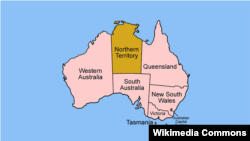A Taiwanese company, TiSPACE, plans to launch Australia's first commercial rocket later this year.
The rocket is called Hapith, which means “flying squirrel” in a Taiwanese Indigenous language.
So far, no specific date for the rocket’s launch has been given. However, officials say an experimental flight is planned this year from a private facility on the Eyre Peninsula in South Australia. Official approval was granted by the Australian government this week.
Developers hope the vehicle will reach outer space, at least 100 kilometers above sea level, before falling back to Earth, over the sea. The rocket’s data, navigation and propulsion systems will be scrutinized.
James Brown, the chief executive of the Space Industry Association of Australia, said it will be a significant mission.
“This is the first, sort of, major rocket launch in about 40 years for Australia,” he said. “So, this is a rocket that is about 10 meters high, it’s got two stages, it’ll be launched from South Australia out over the ocean and it will get to about 100 kilometers high. It is basically testing this Taiwanese technology, which is a rocket built around a hybrid engine, and if that works well, if it is all safe, if it’s all reliable, then the plan is for this company to come back and launch a bigger rocket that is about 20 meters high that can carry up to 400 kilograms worth of satellite payload into space, so it is a really exciting development for the industry.”
TiSPACE is Taiwan’s first private space company, which reportedly chose a launch site in Australia because of regulatory problems back home. The Taipei Times reported concerns over the legality of proposed launch sites in Taiwan.
Researchers have said the project is potentially significant for both Australia’s and Taiwan’s space industries, which have lagged behind other space programs. Australia only established a domestic space agency in 2018.
Alice Gorman, an associate professor at Flinders University and space exploration expert, says Australia is well-positioned to benefit from the global space sector.
“At the top of the country, in the north, we are relatively close to the equator and that is a huge advantage for launching satellites into geostationary orbit because you get the assistance of the Earth’s rotation,” she said. “In the south, where Southern Launch is developing its launch sites, we are perfectly located to launch things into polar orbit, and this is where a lot of our earth observation satellites are, a lot of scientific satellites, and we are not looking at, you know, monumentally massive, big rockets here. We are looking at small rockets, small satellites and with both ends of the country able to specialize in different kinds of launch, we really do have a geographic advantage.”
Australia’s rocket-launching heritage goes back decades. For years, launches were taking place regularly at the Woomera range in South Australia, including missile experiments for the military. The site remains a major Australian defense and research facility.
TiSPACE has said it plans further “suborbital launches and several orbital launches” after this year’s test flight.









